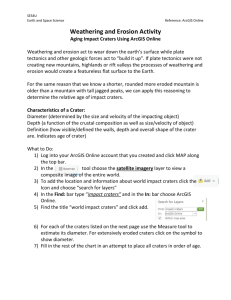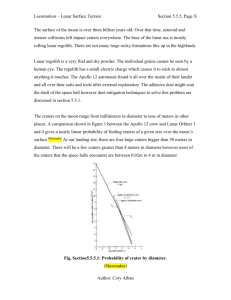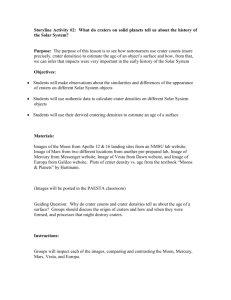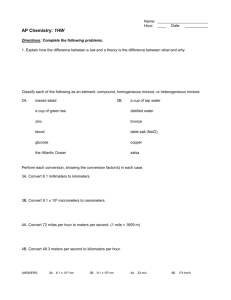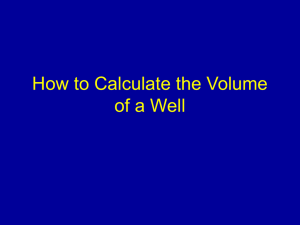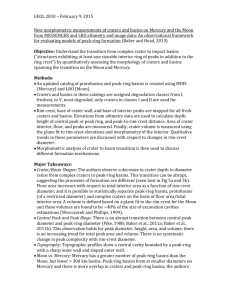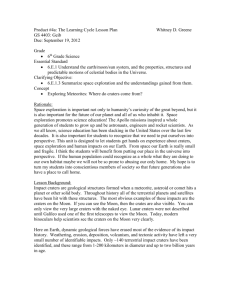Determining the diameter and heights of lunar craters
advertisement
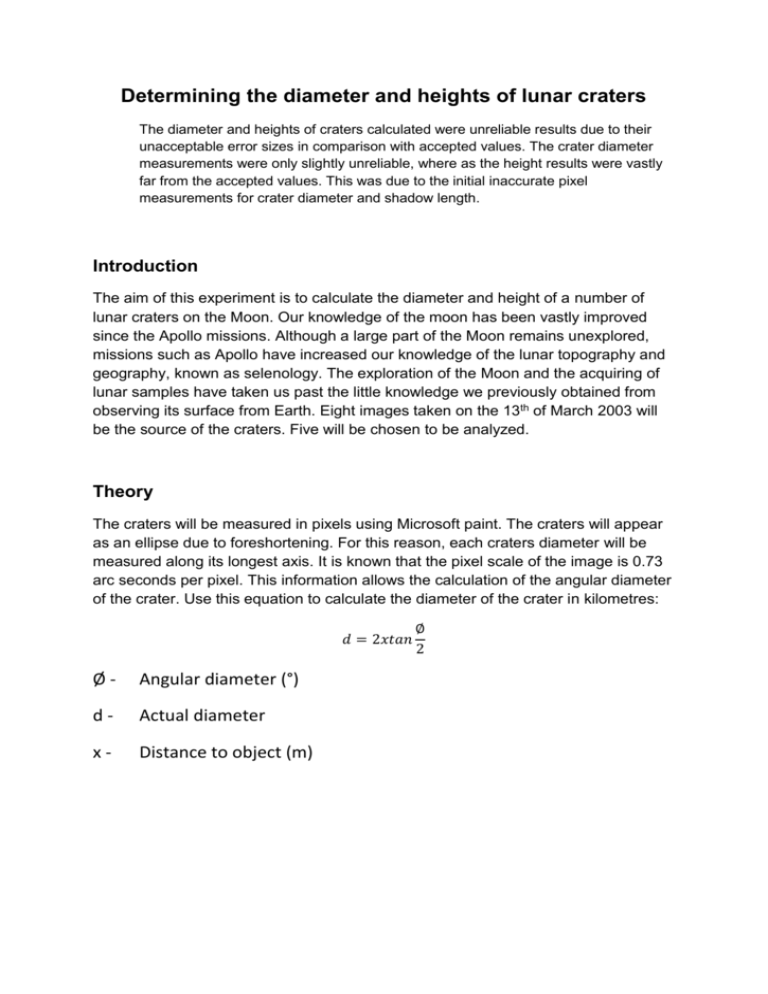
Determining the diameter and heights of lunar craters The diameter and heights of craters calculated were unreliable results due to their unacceptable error sizes in comparison with accepted values. The crater diameter measurements were only slightly unreliable, where as the height results were vastly far from the accepted values. This was due to the initial inaccurate pixel measurements for crater diameter and shadow length. Introduction The aim of this experiment is to calculate the diameter and height of a number of lunar craters on the Moon. Our knowledge of the moon has been vastly improved since the Apollo missions. Although a large part of the Moon remains unexplored, missions such as Apollo have increased our knowledge of the lunar topography and geography, known as selenology. The exploration of the Moon and the acquiring of lunar samples have taken us past the little knowledge we previously obtained from observing its surface from Earth. Eight images taken on the 13th of March 2003 will be the source of the craters. Five will be chosen to be analyzed. Theory The craters will be measured in pixels using Microsoft paint. The craters will appear as an ellipse due to foreshortening. For this reason, each craters diameter will be measured along its longest axis. It is known that the pixel scale of the image is 0.73 arc seconds per pixel. This information allows the calculation of the angular diameter of the crater. Use this equation to calculate the diameter of the crater in kilometres: 𝑑 = 2𝑥𝑡𝑎𝑛 Ø- Angular diameter (°) d- Actual diameter x- Distance to object (m) ∅ 2 Now the height of the crater must be calculated. To do this, the shadow length of the crater must be measured. Fig 1. Diagram of a crater with respect to the suns elevation in order to calculate the craters height. Due to foreshortening the shadows measured length is shorter than the true length. To get the true length, divide the apparent length of the shadow by the cosine of the crater’s selenographic longitude. The next step in calculating the craters height is to obtain a value for α, which is the suns elevation. This requires the use of spherical trigonometry. Fig 2. Diagram of a lunar disc. The crater is marked at C. The zero-point of selenographic coordinates is marked at E. The pole is marked as P. The terminated is marked as T. The sub-solar point is marked as S. Using the following equation you can solve to find CS and α: cos(CS)=cos(PC)cos(PS)+sin(PC)sin(PS)cos(CPS) Experimental Plan of Measurements 1) Identify 5 craters to measure. 2) Open the images in Microsoft paint. 3) Use the cursor to measure the longest axis of each crater in pixels as shown below: Fig 3. Print screen of measuring the diameter of a crater in pixels circled at the bottom of the print screen. 4) Apply the equations previously shown in the theory to measure each craters diameter and height. Results Crater Lansberg Euler Campanus Nöggerath Reinhold Diameter (pixels) 27 19 32 25 30 Actual Diameter Angular diameter (degrees×10-3) (km) 5.48 3.85 6.49 5.07 6.08 Accepted Diameter (km) 37 26 43 34 41 Fig. 3 Table of Diameter results for each crater. Crater Height (km) Lansberg Euler Campanus Nöggerath Reinhold Accepted Height (km) 2.2 1.2 0.1 2.8 0.7 3.6 2.2 2 1.9 2.7 Fig. 4 Table of height results for each crater. Discussion Overall the diameter measurements were not reliable in comparison with accepted values. This is because none of the measurements fell within the allowed error of +/0.7km. The largest difference between the calculated and accepted diameter value was 5km. This error is relating to crater Campanus, the calculated diameter is 43km where as the accepted value is 48km. However, on three occasions the differences in diameter values was only 1km. Craters Lansberg, Euler and Reinhold all had a 1km difference in the calculated and accepted diameter. Although these results are technically unreliable because they don’t fall within the error margins, they are still very close to the accepted values in some cases. The unreliability of the final diameter values are due to the inaccurate pixel measurements initially used. There was a lot of human error in measuring the number of pixels because it was very hard to judge accurately where the crater began and ended. The crater height results were very unreliable in comparison with the accepted height values. This is again due to human error in measuring the number of pixels, to calculate the shadow length. It is very hard to decipher the shadow dimensions because of the different shades of black and grey. 38 27 48 30 42 Conclusion The overall result of the experiment exposed too many inaccuracies in the initial measurements. The inaccurate pixel measurements allowed errors to become greater when working towards the final calculations. Although the craters diameter measurements were not vastly unreliable, the height measurements were too far from the accepted values to be reliable in the slightest.


